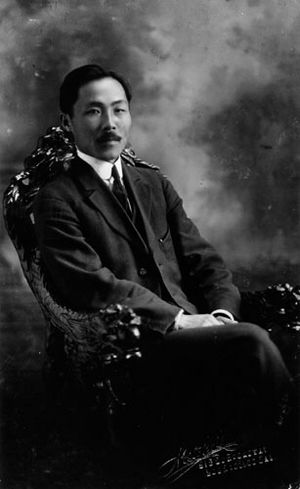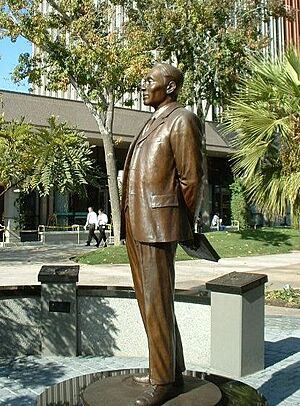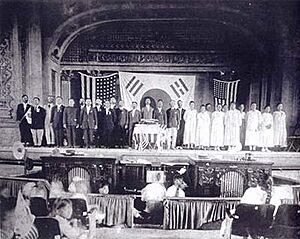Ahn Changho facts for kids
Quick facts for kids
Ahn Chang-ho
안창호 |
|
|---|---|

Ahn in Los Angeles, California
|
|
| 6th President of the Provisional Government of the Republic of Korea | |
| In office May 3, 1926 – May 16, 1926 |
|
| Preceded by | Yi Dongnyeong |
| Succeeded by | Yi Dongnyeong |
| Personal details | |
| Born | November 9, 1878 Kangso County, Pyeongan, Joseon |
| Died | March 10, 1938 (aged 59) Keijō Imperial University Hospital, Gyeongseong-bu, Japanese Korea |
| Nationality | Korean-American |
| Spouse | Helen Lee (Yi Hye-ryon) |
| Children | 5; including Philip, Susan and Ralph |
| Religion | Protestantism (Presbyterianism) |
| Korean name | |
| Hangul | |
| Hanja | |
| Revised Romanization | An Changho |
| McCune–Reischauer | An Ch'angho |

Ahn Chang-ho, also known as Dosan (도산), was an important leader in the Korean independence movement. He was born on November 9, 1878, and passed away on March 10, 1938. He worked hard to free Korea from Japanese rule.
Dosan was also a key figure in the early Korean-American community in the United States. He helped Koreans living abroad organize and work together. He was a Protestant activist who believed in social change.
In 1907, after returning to Korea from the US, he started the Shinminhoe (New Korea Society). This group was very important in fighting against the Japanese occupation. In 1913, he founded the Young Korean Academy in San Francisco. He also played a big part in creating the Provisional Government of the Republic of Korea in Shanghai in 1919.
Many people believe Ahn Chang-ho helped write the lyrics for "Aegukga", which is now the South Korean national anthem. Beyond fighting for independence, Dosan wanted to improve the character of the Korean people and modernize Korea's entire social system. He focused a lot on education. His children include actors Philip Ahn and Ralph Ahn, and US Navy Lieutenant Susan Ahn Cuddy.
Contents
Life Story of Ahn Chang-ho
Early Life and Education
Ahn Chang-ho was born Ahn Chi-sam in 1878 in what is now North Korea. His family name is Ahn. He was the third son of his parents. His family, the Sunheung Ahn clan, has a long history, including the famous scholar An Hyang.
When he was a teenager and started public speaking, he changed his name to Chang-ho. His father also changed his name.
In 1894, Ahn moved to Seoul. The next year, he went to Save the World School, a school supported by Presbyterian missionaries. He later became a Christian. While studying, he also worked at Jejungwon, Korea's first modern hospital. This hospital later became part of Yonsei University.
In 2013, Yonsei University gave Dosan an honorary diploma. This was to recognize his time at the school and his work at the hospital.
Moving to America
In October 1902, Ahn Chang-ho and his wife, Helen Lee, traveled to San Francisco. They wanted to get a better education. They were the first married couple from Korea to come to the United States.
When he arrived in San Francisco, Ahn saw two Korean merchants arguing loudly in the street. This made him sad to see his countrymen behaving poorly overseas. So, he decided to help improve the Korean community there. He quickly became one of its first leaders.
In 1903, he started the Friendship Society (Chinmoke Hoe). This was the first group just for Koreans in the United States. In 1905, he changed its name to the Mutual Assistance Society (MAS). This was the first Korean political group in the US. They also started the first Korean newspaper, Kongnip Sinbo.
Later, in 1909, the MAS joined with another group in Hawaii. They formed the Korean National Association. This organization officially represented Koreans in the United States until the end of World War II.
Returning to Korea
In 1926, Dosan left California by ship and traveled back to China. He never returned to live in the United States for a long time.
During his fight against Japanese rule in Korea, the Japanese government arrested and imprisoned him at least five times. His first arrest was in 1909. He was arrested because of his connection to An Jung-geun, who had assassinated a Japanese official. Dosan faced harsh treatment many times during his activism.
In 1932, he was arrested in Shanghai, China. This was linked to a bombing by Yun Bong-gil at Hongkew Park. Even though he was a Chinese citizen, he was illegally sent back to Korea. There, he was found guilty of breaking Japan's "Preservation of Peace Laws" and sent to prison for five years.
His Final Days
In 1937, Japanese authorities arrested Ahn again. But he was very sick with an internal illness. So, he was released on bail and moved to a hospital in Seoul. He passed away there on March 10, 1938.
The Japanese military worried that Ahn Chang-ho's death might cause protests. So, they limited the number of people who could attend his funeral. Only a small number of his relatives were allowed to be there.
Ahn Chang-ho's Lasting Impact
Many people see Ahn Chang-ho as one of Korea's most important moral and thoughtful leaders of the 20th century. During the difficult time before and during the Japanese occupation, he urged Koreans to renew their spirit and character. He believed that education was a key part of their fight for independence and for building a democratic society. Dosan also included economic and military plans in his independence strategies.
To honor his memory, the Dosan Park and a Memorial Hall were built in Seoul. Another memorial stands in Riverside, California. Ahn's family home in Los Angeles has been restored by the University of Southern California.
The USPS Post Office in Koreatown, Los Angeles, was named the Dosan Ahn Chang Ho Station. This was the first USPS building named after an Asian person.
In 2011, the Ellis Island Foundation placed a plaque honoring Dosan. This marked 100 years since he entered the United States through Ellis Island.
The city of Los Angeles also named an intersection "Dosan Ahn Chang Ho Square" in his honor. In 2002, a major freeway interchange in downtown Los Angeles was renamed the Dosan Ahn Chang Ho Memorial Interchange.
In ITF-style Taekwondo, a set of 24 movements is called "Do-San" or "Dosan" in his honor. This pattern is needed for students to advance to the next belt level.
In 2012, Ahn was honored at the International Civil Rights Walk of Fame in Atlanta, Georgia. His grandson accepted the award for him.
On November 8, 2013, Yonsei University gave Dosan an honorary diploma. This recognized his work as a teaching assistant and his influence on many students.
The Republic of Korea Navy named a submarine, the Dosan Ahn Changho-class submarine, after him. The first ship of this class began service in 2021.
Family
- Helen Lee (Yi Hye-ryon), 1884–1969
- Philip Ahn, 1905–1978
- Philson Ahn, 1912–2001
- Susan Ahn Cuddy, 1915–2015
- Soorah Ahn Buffum, 1917–2016
- Ralph Ahn, 1926–2022
See Also
 In Spanish: Ahn Chang-ho para niños
In Spanish: Ahn Chang-ho para niños
- Korea under Japanese rule
- Korean independence movements
- List of Koreans
Images for kids











